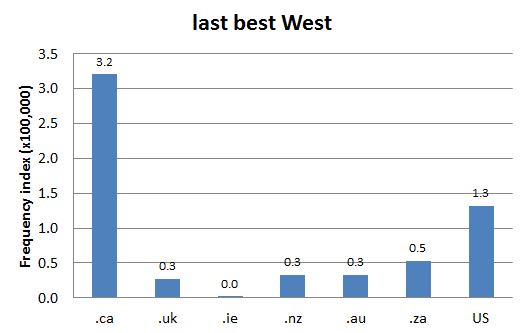DCHP-2
last best West Last Best West, last Best West DCHP-2 (October 2016)
n. — historical, Geography
an early 20th-century name for the Canadian prairies (see Image 1).
Type: 4. Culturally Significant — The last best West has its origins in the transfer of Rupert's Land and the North-Western Territory from the Hudson's Bay Company to Canada in 1870, and the ensuing Dominion Lands Act of 1872. The Act aimed to encourage settlement in the recently acquired Northwest Territories (out of which Alberta and Saskatchewan were created in 1905) and the newly created province of Manitoba, by providing free homesteads to eligible men from Britain, the US, Europe and Eastern Canada (see Canadian Encyclopedia reference for more information). Although the term was not used in the Act itself, the marketing campaign to promote the Act successfully used the phrase to entice potential settlers (see, e.g. the 1908 quotation). The campaign was hugely successful: between 1896 and 1914, two million people emigrated to Canada, transforming the Canadian West (see Library and Archives Canada reference "The Canadian West - Immigration"). The Canadian government also introduced block settlements, allowing entire communities to move to Canada together (see Library and Archives Canada reference "The Canadian West - Federal Administration").
The policy paralleled the US Homestead Acts, and the term last best West was inspired by the fact that the more easily accessible US West had already been largely settled.
The term continues to be most prevalent in Canada (see Chart 1), and retains cultural significance in the Prairie provinces (see, e.g. the 1994 and 2007 quotations).
See also COD-2, s.v. "last best West", which is marked "Cdn".See also: Northwestern Territory Rupert's Land
References:
- COD-2
- Canadian Encyclopedia s.v. "Dominion Lands Policy" Accessed 10 Feb. 2016
- Library and Archives Canada "The Canadian West - Federal Administration" Accessed 31 Jul. 2013
- Library and Archives Canada "The Canadian West - Immigration" Accessed 31 Jul. 2013
Images:

Image 1: A promotional poster for homesteads in the Canadian West, 1907. Source: Wikimedia Commons. Photo: The Globe -- Toronto : Globe Printing Co.
Chart 1: Internet Domain Search, 31 Jul. 2013
